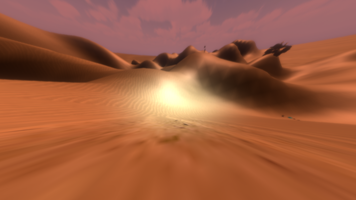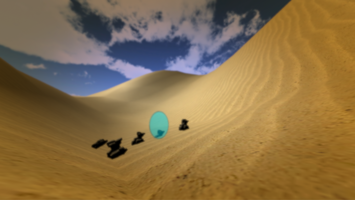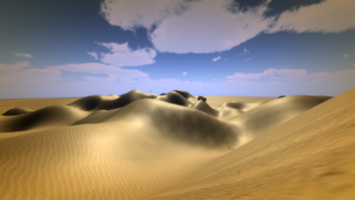The Desert - Post-Mortem




The Desert Post-Mortem
Positive - Managing Tasks
Over the three weeks that I had available to work on The Desert, I spent heavy amounts of time making sure that everything that I was working on was documented and labelled. By doing this, I was able to retain my memory of what I decided was the most important to the least important tasks that had to be done and when the due date for that task is. When tasked were not completed in the correct week they were supposed to be, that task would be shifted to the following week and tagged as high importance to make sure I don’t continue to neglect it. I was able to continually accomplish this by using the software Hack n Plan and its multiple tools of tracking progress with initially creating the tasks, adding timestamps, adding subtasks to unpack what the individual elements of a task, labelling importance, and displaying the tasks due date. By making sure I spend time each day going through my hack n plan, I was able to stay on top of my goals. If I was not to use software that allowed the user to easily add, rotate and change tasks, I know that I would have been finding it a lot trickier to remember what I should have to complete and what had already completed. One of the biggest flaws I have made on previous projects is that I would attempt to work on a task without documenting it on anything and would not be able to remember after some time what I worked on, why I worked on it, or what I need to work on. In future projects, to ensure success when managing my tasks and resources, having a task tracker will be essential as well as using the lesser-known features such as adding subtasks or descriptions as they enhance the practical use by allowing the user not just to remember the general task to be completed but as well the individual pieces of that task and how to solve them. Additionally, in future to further gain success in this area, I will utilise a calendar so that I can outline what I should be working on each day and what time that should take place. If I use a digital calendar, I can also have the ability to relocate working times if I happen to miss one which will improve my motivation to complete them because if I missed one day and had no way to change it, it would likely discourage me to work on the task.
Now that my project for Leaving your Fingerprints is coming to a close, I have started to regret how late I started the polishing phase of my game. I believe the main feature in the game that suffered due to this neglect was the exploration and walking part of the game. I wasn’t able to make my own map for the game and it really shows due to the walking not feeling designed around the map at all. The player will struggle to climb the sand dunes which makes the experience feel unpolished and lazy. Although this was very annoying, I have learned a lesson that the core gameplay of the game needs to be built with the environment in mind otherwise the experience is going to feel out of place. If I had started investigating the issue with that mindset earlier, I would have been able to arrive to a conclusion that would have suited the gameplay more effectively and ultimately, lead to a better experience overall. A main reason for this issue taking place was the time schedule I had and possibly over-scoping the project for a three-week assignment. I wanted climbing the sand dunes to be seamless and the sand dunes to properly look like sand dunes while also giving the player fast speeds down when tobogganing. Additionally, this has been my first complete 3D project and I think due to my naivety to 3D creation, I underestimated the difficulties that occur when making a 3D environment. For example, when coming up with concepts for a game about sand tobogganing, I never imagined that climbing sand dunes would be a problem or that sometimes when the player tries to toboggan down a dune, they simply won’t go down. These were major problems that I failed to plan for and due to that fact, I lost a lot of development time by trialling and erroring solutions. I ended up having to finalise a version that was good enough for the time so that I could begin completing other tasks which meant even though I don’t hate the movement mechanics in the game now, I know I could’ve made them a lot better by having more time for polishing. Therefore, I have learned a variety of ways that I can improve when working on upcoming projects. These include planning roadblocks and obstacles before beginning a project so that I can plan to have room for failure. By achieving this, I will be able to better control stress as I know that even though I’m encountering a problem, I have a secondary plan that can help me progress through it which will end up giving me more time to polish the final product. Additionally, when I work with foreign technology such as my first attempts at a 3D project, I will have to first research the topic to get an understanding of how it works, how it can interact with other elements in the game world and so on. Through this, I will be able to understand potential roadblocks and use that to plan out areas where I will likely struggle at.
Positive - Improving Via Feedback
Throughout my assignment, Leaving your Fingerprint, we had four playtest where classmates would play your game and then give it feedback. For each playtest we would make a questionnaire that the players would answer. Each time I created the questionnaire, I wanted to ask questions that were relevant on the features that I was only recently implemented or on a feature that in my eyes, wasn’t as good as it could be and wanted to know how it could improve. By getting an outside view on your project, you are able to see the opinions of people that don’t know every component of your game and can instead give an objective dialogue on the feature. Every day after the playtest was completed, I would go through all of the feedback and test out how the game would feel like if I incorporated their ideas in the game. This usually included tweaking values, redesigning features, and removing elements that were strayed too far from the original design of the game. I was able to make the audiences feedback work really well when working on my game as even if the feedback seemed quite harsh, I wanted to look at it objectively and see if this person has a point. I found this to be a lot better than ignoring anyone that had differing opinions from mine. Without players input on the movement system in my game, the player’s movement would’ve stayed at an extremely sluggish state as when testing I didn’t mind it as it was my original intention. Even though my intention was to have it slow, I didn’t consider that it flat out made the experience a boring game that no one in the right mind would ever want to play. By playtesting, I was able to understand that my original design for the game was poor and that ultimately, the developer needs to make the experience enjoyable for the user otherwise they are going to quit the game and likely not return. For future projects, looking at user feedback will always be a high priority as they are viewing your game from an outsiders perspective, usually in terms of how enjoyable the experience was to them. Therefore, making a robust questionnaire that questions the user on all of the main elements of your project is desirable as those elements are what the player will experience and if they are as good as they can be, it will be easier to make a project around those solid features.
Files
Get The Desert
The Desert
The Sand Tobogganing Experience!
| Status | Released |
| Author | Showmen Games |
| Genre | Adventure |
| Tags | 3D, Exploration, Horror, Open World, Sandbox, tobogganing |
More posts
- Version: 1.1.0 (Pre Launch)Apr 02, 2020

Leave a comment
Log in with itch.io to leave a comment.